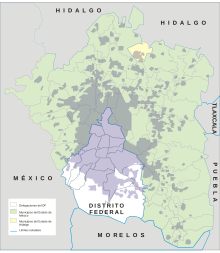Historically, and since pre-Hispanic times, the valley of Anáhuac has been one of the most densely populated areas in Mexico. When the Federal District was created in 1824, the urban area of Mexico City extended approximately to the area of today's Cuauhtémoc borough. At the beginning of the 20th century, the elites began migrating to the south and west and soon the small towns of Mixcoac and San Ángel were incorporated by the growing conurbation. According to the 1921 census, 54.78% of the city's population was considered Mestizo (Indigenous mixed with European), 22.79% considered European, and 18.74% considered Indigenous. In 1921, Mexico City had less than one million inhabitants.
Up to the 1980s, the Federal District was the most populous federal entity in Mexico, but since then its population has remained stable at around 8.7 million. The growth of the city has extended beyond the limits of the Federal District to 59 municipalities of the state of Mexico and 1 in the state of Hidalgo. With a population of approximately 19.8 million inhabitants (2008), it is one of the most populous conurbations in the world. Nonetheless, the annual rate of growth of the Metropolitan Area of Mexico City is much lower than that of other large urban agglomerations in Mexico, a phenomenon most likely attributable to the environmental policy of decentralization. The net migration rate of the Federal District from 1995 to 2000 was negative.
While they represented around 18.74% of the city's population, indigenous peoples from different regions of Mexico have immigrated to the capital in search of better economic opportunities. Náhuatl, Otomí, Mixteco, Zapoteco, and Mazahua are the indigenous languages with the greatest number of speakers in Mexico City.
On the other hand, Mexico City is home to large communities of expatriates and immigrants, most notably from South America (mainly from Argentina, but also from Chile, Uruguay, Colombia, Brazil and Venezuela), from Europe (mainly from Spain and Germany, but also from France, Italy, Poland and Romania), the Middle East (mainly from Lebanon and Syria), and recently from Asia (mainly from China and South Korea). While no official figures have been reported, population estimates of each of these communities are quite significant. Mexico City is home to the largest population of Americans living outside the United States. Some estimates are as high as 600,000 U.S. Americans living in Mexico City, while in 1999 the U.S. Bureau of Consular Affairs estimates over 440,000 Americans lived in the Mexico City Metropolitan Area.
The majority (90.5%) of the residents in Mexico City are Roman Catholic, higher than the national percentage, even though it has been decreasing over the last decades. However, many other religions and philosophies are also practiced in the city: many different types of Protestant groups, different types of Jewish communities, Buddhist and Islam and other philosophical groups, as well as atheism.



No comments:
Post a Comment